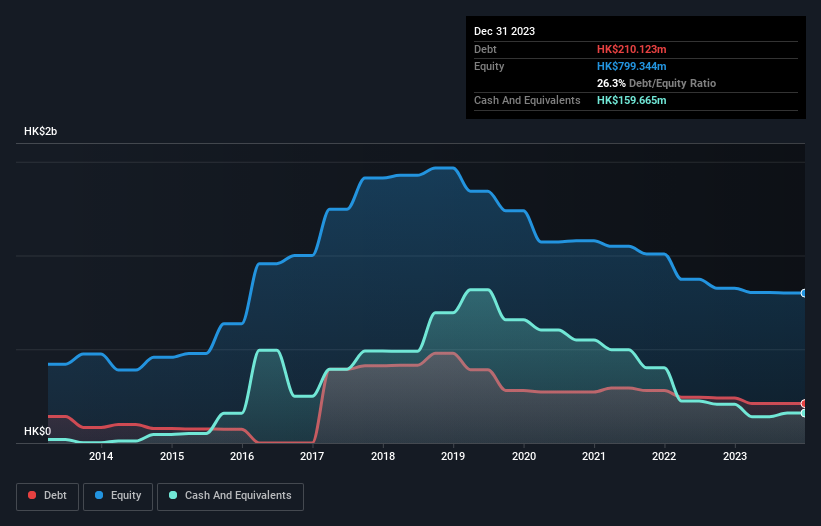Legendary fund manager Li Lu (who Charlie Munger backed) once said, 'The biggest investment risk is not the volatility of prices, but whether you will suffer a permanent loss of capital.' When we think about how risky a company is, we always like to look at its use of debt, since debt overload can lead to ruin. We note that Applied Development Holdings Limited (HKG:519) does have debt on its balance sheet. But the real question is whether this debt is making the company risky.
When Is Debt Dangerous?
Generally speaking, debt only becomes a real problem when a company can't easily pay it off, either by raising capital or with its own cash flow. In the worst case scenario, a company can go bankrupt if it cannot pay its creditors. However, a more common (but still painful) scenario is that it has to raise new equity capital at a low price, thus permanently diluting shareholders. Of course, debt can be an important tool in businesses, particularly capital heavy businesses. The first thing to do when considering how much debt a business uses is to look at its cash and debt together.
View our latest analysis for Applied Development Holdings
What Is Applied Development Holdings's Debt?
The image below, which you can click on for greater detail, shows that Applied Development Holdings had debt of HK$210.1m at the end of December 2023, a reduction from HK$240.3m over a year. However, it also had HK$159.7m in cash, and so its net debt is HK$50.5m.

How Healthy Is Applied Development Holdings' Balance Sheet?
According to the last reported balance sheet, Applied Development Holdings had liabilities of HK$388.8m due within 12 months, and liabilities of HK$91.5m due beyond 12 months. Offsetting these obligations, it had cash of HK$159.7m as well as receivables valued at HK$28.0m due within 12 months. So its liabilities outweigh the sum of its cash and (near-term) receivables by HK$292.7m.
Given this deficit is actually higher than the company's market capitalization of HK$201.6m, we think shareholders really should watch Applied Development Holdings's debt levels, like a parent watching their child ride a bike for the first time. Hypothetically, extremely heavy dilution would be required if the company were forced to pay down its liabilities by raising capital at the current share price. There's no doubt that we learn most about debt from the balance sheet. But you can't view debt in total isolation; since Applied Development Holdings will need earnings to service that debt. So when considering debt, it's definitely worth looking at the earnings trend. Click here for an interactive snapshot.
It seems likely shareholders hope that Applied Development Holdings can significantly advance the business plan before too long, because it doesn't have any significant revenue at the moment.
Caveat Emptor
While Applied Development Holdings's falling revenue is about as heartwarming as a wet blanket, arguably its earnings before interest and tax (EBIT) loss is even less appealing. Indeed, it lost HK$14m at the EBIT level. Considering that alongside the liabilities mentioned above make us nervous about the company. It would need to improve its operations quickly for us to be interested in it. Not least because it had negative free cash flow of HK$39m over the last twelve months. That means it's on the risky side of things. The balance sheet is clearly the area to focus on when you are analysing debt. However, not all investment risk resides within the balance sheet - far from it. These risks can be hard to spot. Every company has them, and we've spotted 3 warning signs for Applied Development Holdings you should know about.
If you're interested in investing in businesses that can grow profits without the burden of debt, then check out this free list of growing businesses that have net cash on the balance sheet.
Valuation is complex, but we're here to simplify it.
Discover if Novautek Technologies Group might be undervalued or overvalued with our detailed analysis, featuring fair value estimates, potential risks, dividends, insider trades, and its financial condition.
Access Free AnalysisHave feedback on this article? Concerned about the content? Get in touch with us directly. Alternatively, email editorial-team (at) simplywallst.com.
This article by Simply Wall St is general in nature. We provide commentary based on historical data and analyst forecasts only using an unbiased methodology and our articles are not intended to be financial advice. It does not constitute a recommendation to buy or sell any stock, and does not take account of your objectives, or your financial situation. We aim to bring you long-term focused analysis driven by fundamental data. Note that our analysis may not factor in the latest price-sensitive company announcements or qualitative material. Simply Wall St has no position in any stocks mentioned.
About SEHK:519
Novautek Technologies Group
An investment holding company, engages in resort and property development, and property investment activities in the People’s Republic of China, Hong Kong, the Middle East, and Southeast Asia.
Adequate balance sheet with slight risk.
Market Insights
Community Narratives



